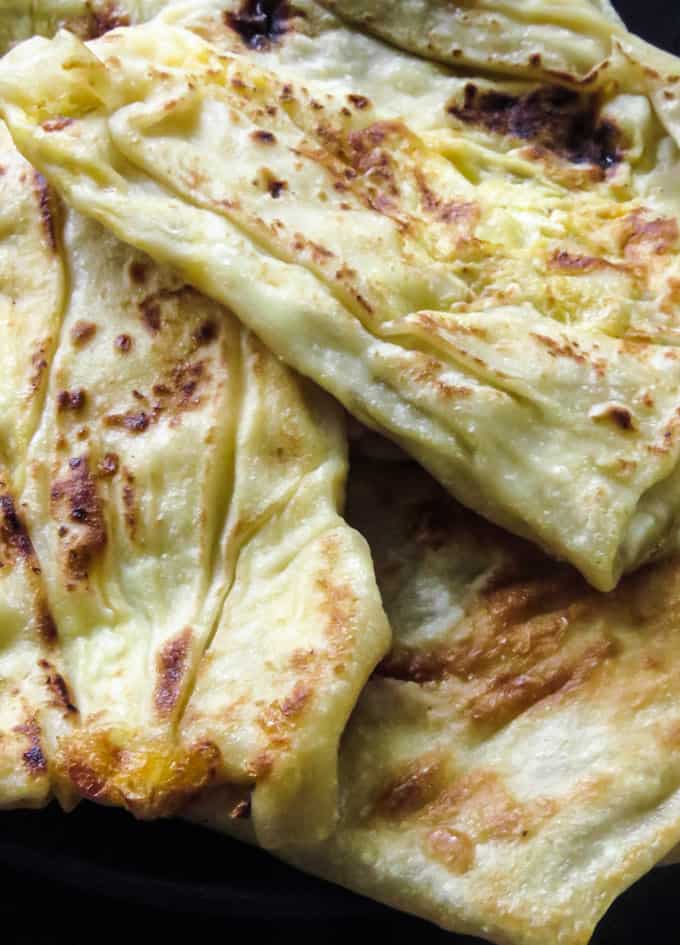Sri Lankan Coconut Roti – A Flatbread Full of Flavor
In Sri Lanka, breakfast is far from bland — and pol roti (coconut roti) is a staple that proves just that. This humble flatbread, made with freshly grated coconut and flour, is pan-fried to perfection and typically served with spicy sambols or warm dhal curry.

🌴 What is Pol Roti?
Pol roti is a rustic, satisfying coconut flatbread that’s easy to make and even easier to love. It’s dense, chewy, and slightly nutty from the coconut — ideal for scooping up saucy curries or pairing with a spicy onion sambol (lunu miris). No yeast, no waiting hours — just a handful of ingredients and a hot pan.
Origins & History of Sri Lankan Roti (Pol Roti)
Pol roti likely has its roots in ancient South Indian and Sri Lankan village cooking, where flatbreads made from locally grown grains or rice were common. As coconut became a staple crop in Sri Lanka — especially along the coasts — it was naturally incorporated into everyday cooking. The result: a unique, dense, chewy flatbread that differs from Indian chapati or paratha thanks to the rich flavor and moisture of fresh grated coconut.
The technique of cooking flatbreads over a hot griddle or clay pan (thachchiya) has existed in Sri Lanka for centuries, passed down in home kitchens rather than written down. Pol roti, in that sense, is a peasant food — affordable, nourishing, and made from ingredients always on hand: flour, coconut, water, and salt.
Cultural Significance
- Common in rural households, where breakfast and dinner often feature roti, sambol, and tea.
- It’s also considered practical travel food, as the rotis can be eaten cold and stored without refrigeration.
- While now made with wheat flour, early versions may have used kurakkan (finger millet) or rice flour, showing a shift in ingredients over time based on availability and trade.
Influence from Colonization & Trade
- The use of wheat flour in modern-day pol roti came with colonial imports — Portuguese, Dutch, and British powers brought in flour and baking techniques. But unlike baked bread, Sri Lankan roti stayed true to its flatbread roots: no oven, no yeast, no fluff — just pan and flame.
Today
- Pol roti has become a national comfort food, found in roadside eateries (hotels), family homes, and breakfast buffets alike. It's often modernized with fillings like onion, chili, or curry leaves, but the essence remains the same: simple, hearty, deeply Sri Lankan.
🧄 How It’s Eaten in Sri Lanka
Pol roti is often part of a typical Sri Lankan breakfast or light dinner. It’s traditionally served with:
- Lunu miris – a fiery onion and chili relish
- Katta sambol – dried chili and lime-based condiment
- Dhal curry – comforting, mild spiced lentil stew
- Or simply with a pat of butter and cup of Ceylon tea
It’s a dish of few ingredients but rich in cultural value, loved across the island for its simplicity and versatility.
Share this recipe
Sri Lankan Coconut Roti

NUTRITION
Ingredients
- 200 g all-purpose flour
- 100 g desiccated grated coconut
- 3 g salt
- 100-120 ml warm water
- 10 g coconut oil
Instructions
- In a large bowl, combine flour, grated coconut, and salt.
- Gradually add warm water, mixing until a soft, non-sticky dough forms.
- Knead for 2–3 minutes. Cover and let it rest for 15 minutes.
- Divide the dough into 6 equal balls.
- Flatten each ball into a disc, about 0.5 cm thick.
- Heat a skillet or non-stick pan over medium heat and brush with coconut oil.
- Cook each roti for 2–3 minutes per side, until golden spots appear.
- Serve warm with lunu miris, dhal curry, or coconut sambol.

